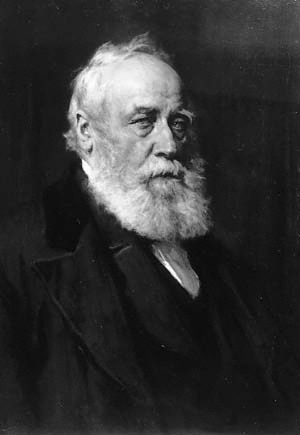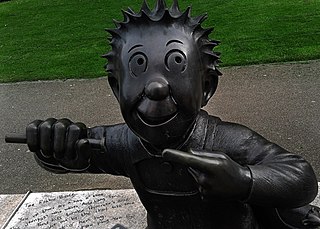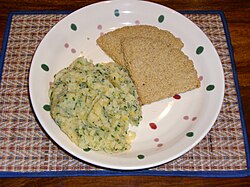
Trifle is a layered dessert of English origin. The usual ingredients are a thin layer of sponge fingers or sponge cake soaked in sherry or another fortified wine, a fruit element, custard and whipped cream layered in that order in a glass dish. The contents of a trifle are highly variable and many varieties exist, some forgoing fruit entirely and instead using other ingredients, such as chocolate, coffee or vanilla. The fruit and sponge layers may be suspended in fruit-flavoured jelly, and these ingredients are usually arranged to produce three or four layers. The assembled dessert can be topped with whipped cream or, more traditionally, syllabub.

William Forbes Skene WS FRSE FSA(Scot) DCL LLD, was a Scottish lawyer, historian and antiquary.

Oor Wullie is a Scottish comic strip published in the D.C. Thomson newspaper The Sunday Post. It features a character called Wullie; Wullie is a Scots nickname for boys named William, equivalent to Willie. His trademarks are spiky hair, dungarees and an upturned bucket, which he uses as a seat: most strips since early 1937 begin and end with a single panel of Wullie sitting on his bucket. The earliest strips, with little dialogue, ended with Wullie complaining. The artistic style settled down by 1940 and has changed little since. A frequent tagline reads, "Oor Wullie! Your Wullie! A'body's Wullie!".

The Broons is a comic strip in Scots published in the weekly Scottish newspaper The Sunday Post. It features a Brown family, which lives in a tenement flat at 10 Glebe Street in the fictional Scottish town of Auchentogle or Auchenshoogle.

Tablet is a medium-hard, sugary confection from Scotland. Tablet is usually made from sugar, condensed milk, and butter, which is boiled to a soft-ball stage and allowed to crystallise. It is often flavoured with vanilla and sometimes has nut pieces in it.

Stovies is a Scottish dish based on potatoes. Recipes and ingredients vary widely but the dish contains potatoes, fat, usually onions and often pieces of meat. In some versions, other vegetables may also be added.

Jacqueline Margaret Kay,, is a Scottish poet, playwright, and novelist, known for her works Other Lovers (1993), Trumpet (1998) and Red Dust Road (2011). Kay has won many awards, including the Somerset Maugham Award in 1994, the Guardian Fiction Prize in 1998 and the Scottish Mortgage Investment Trust Book of the Year Award in 2011.
Glasgay! Festival was a gay, lesbian, bisexual and transgender arts festival in Glasgow, Scotland.

Muriel Janet Gray FRSE is a Scottish author, broadcaster and journalist. She came to public notice as an interviewer on Channel 4's alternative pop-show The Tube, and then appeared as a regular presenter on BBC radio. Gray has written for Time Out, the Sunday Herald and The Guardian, among other publications, as well as publishing successful horror novels. She was the first woman to have been Rector of the University of Edinburgh and is the first female chair of the board of governors at Glasgow School of Art.

Scottish cuisine encompasses the cooking styles, traditions and recipes associated with Scotland. It has distinctive attributes and recipes of its own, but also shares much with other British and wider European cuisine as a result of local, regional, and continental influences—both ancient and modern.

Mince and tatties is a Scottish dish which consists of ground beef and mashed potato. Other vegetables or thickening agents are sometimes added to the dish as well. The dish is also part of Jamaican cuisine, having been introduced to the island by Scottish immigrants to Jamaica during the 18th and 19th centuries, and was frequently served as part of school meals in Scotland during the 20th century.

A full breakfast is a substantial cooked breakfast meal, often served in Great Britain and Ireland. The typical ingredients are bacon, sausages, eggs, black pudding, baked beans, tomatoes, mushrooms, toast, fried bread and a beverage such as coffee or tea. Hash browns are a common contemporary but non-traditional inclusion. Ingredients may extend beyond these or include regional variants, which may often be referred to by different names depending on the area. While it is colloquially known as a "fry-up" in most areas of the United Kingdom and Ireland, it is usually referred to as a "full English", a "full Irish", "full Scottish", "full Welsh", and "Ulster fry", in England, the Republic of Ireland, Scotland, Wales, and Northern Ireland, respectively.

Ross William Ford is a Strength and Conditioning coach for the Scottish Rugby Academy. He was previously a Scotland international rugby union player who played as a hooker. He made 110 test appearances for Scotland, making him their most-capped male player. He played in three World Cups and toured with the British & Irish Lions in 2009, making one appearance.

An oatcake is a type of flatbread similar to a cracker or biscuit, or in some versions takes the form of a pancake. They are prepared with oatmeal as the primary ingredient, and sometimes include plain or wholemeal flour as well. Oatcakes are cooked on a griddle or baked in an oven.

Fruit pudding is a Scottish dish which is a mixture of wheat or oatmeal flour or breadcrumbs, beef suet, brown sugar, currants, raisins, sultanas, salt and cinnamon, formed into the shape of a large sausage.
Emma Smith Gillies (1900–1936) was a Scottish potter best known for her early adaptation of Art Deco painted vases and jugs.
The morning roll is an airy, chewy bread roll popular in Scotland.

Catherine Hogg Blair was a Scottish suffragette, magistrate, founder of the Scottish Women's Rural Institute (SWRI), and member of the Women's Social and Political Union (WSPU). Blair was a passionate campaigner and spokeswoman for rural women, dedicated to doing 'all in her power to further the interests of women'. In 1940, Blair's history of the Scottish Women's Rural Institute Rural Journey: A History of the S.W.R.I. From Cradle to Majority was published, summarising the achievements and goals of the organisation since its inception in 1917. Blair was also a skilled potter, founding Mak'Merry pottery studio in the town of MacMerry, East Lothian.
Hatted kit, or hattit kit, is a traditional Scottish milk dish. The fresh milk used in the recipe must be warm and traditionally it was made by milking straight from a cow into a pail or other vessel containing fresh buttermilk and sometimes rennet. Recipes variously instruct to mix well or to refrain from stirring. More milk was added at the next milking. The resultant "hat" that floats atop the whey is then skimmed off and mixed with sugar, nutmeg or cinnamon and sometimes wine. The hatted kit tends to become more acid, so limewater or charcoal may be added with later use of a batch. It may be served with cream, stewed fruit or with brown bread and salt, instead of butter.















